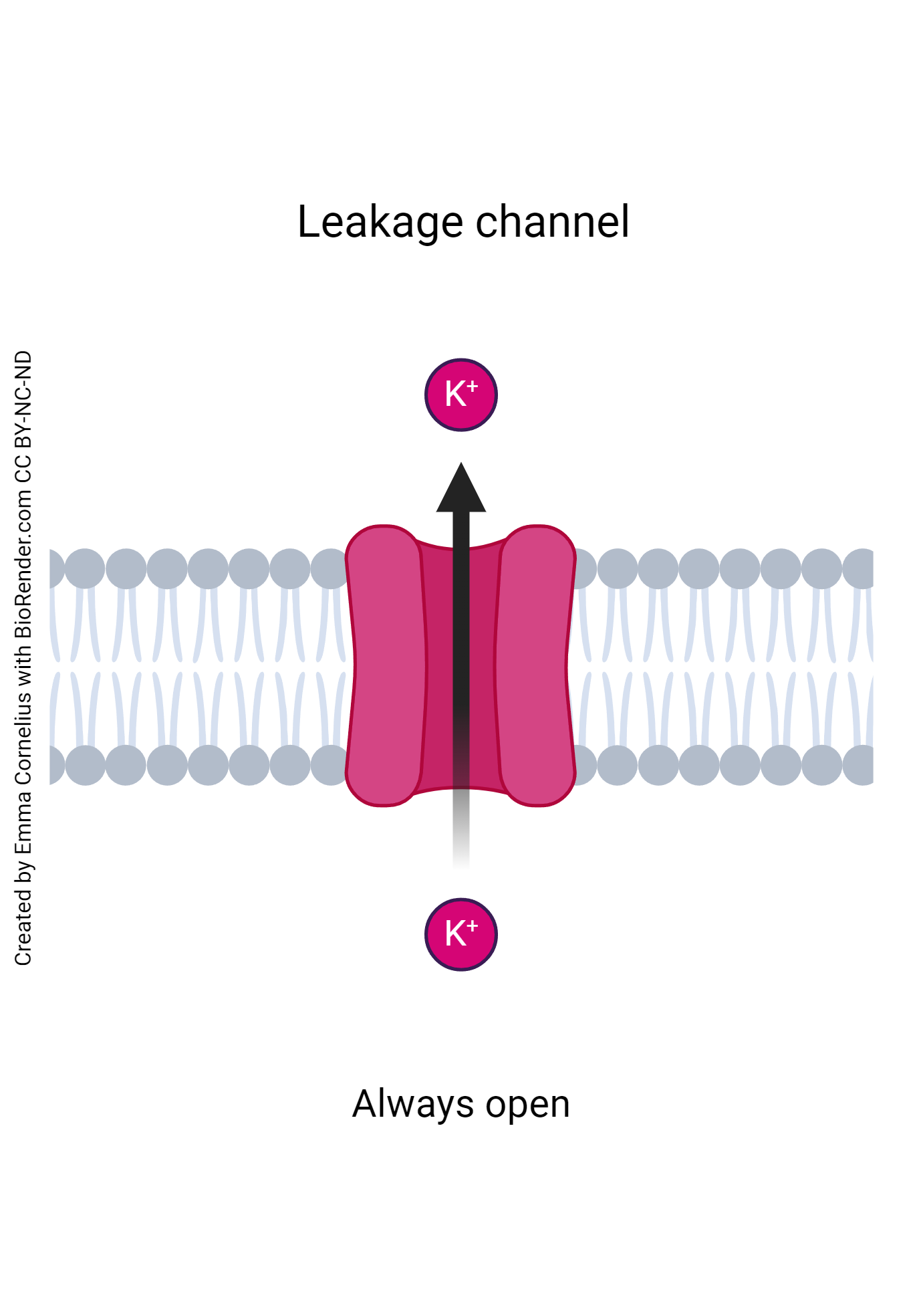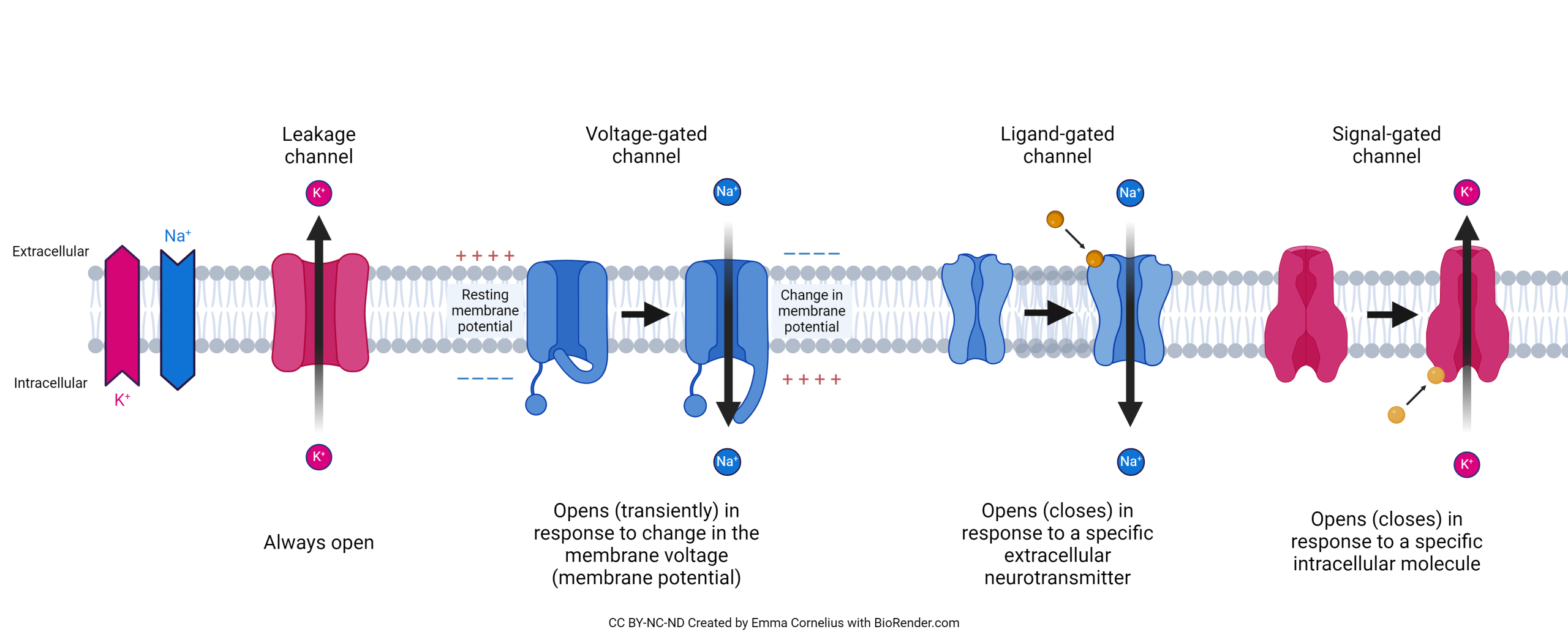The Goldman-Hodgkin-Katz Equation
Caleb Bevan
Objective 6: Show how the Goldman-Hodgkin-Katz equation can be used to predict the membrane potential of neurons under various conditions.
Neuronal Membranes Objective 6 Video Lecture

Before we could study single protein channels using the patch-clamp method, electrophysiologists developed electrical models of the neuronal membrane. They imagined exactly what we later found: nanoscale protein channels essentially shaped like elongated donuts, with a central pore.
The channels that were always open were called leakage channels. In electrical circuit terms, they were described as resistors. Resistors are elements in an electric circuit that allow current to flow, but with some restrictions.
 The channels that were sometimes open and sometimes closed were called gated channels. In electrical terms, this is like a volume knob (variable resistor). The resistance can vary from near-infinity (when the gate is closed) to near-zero (when the gate is open).
The channels that were sometimes open and sometimes closed were called gated channels. In electrical terms, this is like a volume knob (variable resistor). The resistance can vary from near-infinity (when the gate is closed) to near-zero (when the gate is open).
As we’ve said before, the flow of ions across the neuronal cell membrane is regulated by the summed action of all the channels, transporters, and pumps. We will gather all the sources of electrical conductance for potassium, and call them collectively gNa. Then we do the same for sodium conductance (gK) and chloride conductance (gCl). Each of these conductance’s contributes to the electrical potential (voltage) across the cell membrane. How much it contributes is determined by how strong the potential energy force is, and that’s given by the equilibrium potential for the ion (ENa, EK, or ECl), as we saw earlier.
The potential energy difference across the cell membrane is also called the membrane voltage (Vm). This is given by combining the terms in the above paragraph in this way: (The original version developed by David E. Goldman, Alan Lloyd Hodgkin, and Bernard Katz uses permeability, P, instead of g. Permeability only considers the chemical properties of the ions, where g considers the electrical conductivity of the ions.)
(The original version developed by David E. Goldman, Alan Lloyd Hodgkin, and Bernard Katz uses permeability, P, instead of g. Permeability only considers the chemical properties of the ions, where g considers the electrical conductivity of the ions.)
This calculator will allow you to play with the values in the GHK equation (the permeability version of the equation is used, but it works the same way), but if you’re not in the mood for that, here’s the short version.
If you’ve taken an algebra class, then you know that equations with addition and subtraction in the numerator (top terms, above the line) and denominator (bottom terms, below the line) are really hard to analyze. We use something in math called The Method of Limits to figure this out. Because zero does magical things, let’s try zero.
What is the conductivity of an ion that cannot move? It’s zero. So if only potassium ions can move, then the conductivity of sodium (gNa) is zero, and the conductivity of chloride (gCl) is zero, and we get:

because now it doesn’t matter what the equilibrium potential for sodium is. Sodium can’t move, so it can’t reach equilibrium. In mathematical terms, gNa = 0 and so
(gNa) x (ENa) = 0
Similarly, chloride can’t move, so it can’t reach equilibrium. In mathematical terms, gCl = 0 and so
(gCl) x (ECl) = 0
Now gK is on top and bottom and
gK / gK = 1
Any number times 1 is itself.
Vm = EK
This is satisfying, because we already worked it out already using diagrams. When potassium (K) is the only thing that can move, then the membrane voltage reaches the potassium equilibrium potential (EK).
You can do the same thing for sodium (Na) and chloride (Cl) and you’ll get the same thing.
If only sodium can move, then:
Vm = ENa
If only chloride can move, then:
Vm = ECl
When only one ion can move, it reaches its equilibrium potential because it moves until it gets there, and stays there, unless something disturbs that equilibrium.
Media Attributions
- Leakage channel © Emma Cornelius is licensed under a CC BY-NC-ND (Attribution NonCommercial NoDerivatives) license
- Ion Channels © Emma Cornelius is licensed under a CC BY-NC-ND (Attribution NonCommercial NoDerivatives) license
- GHK equation © Jim Hutchins is licensed under a CC BY-SA (Attribution ShareAlike) license
- GHK potassium only © Jim Hutchins is licensed under a CC BY-SA (Attribution ShareAlike) license

